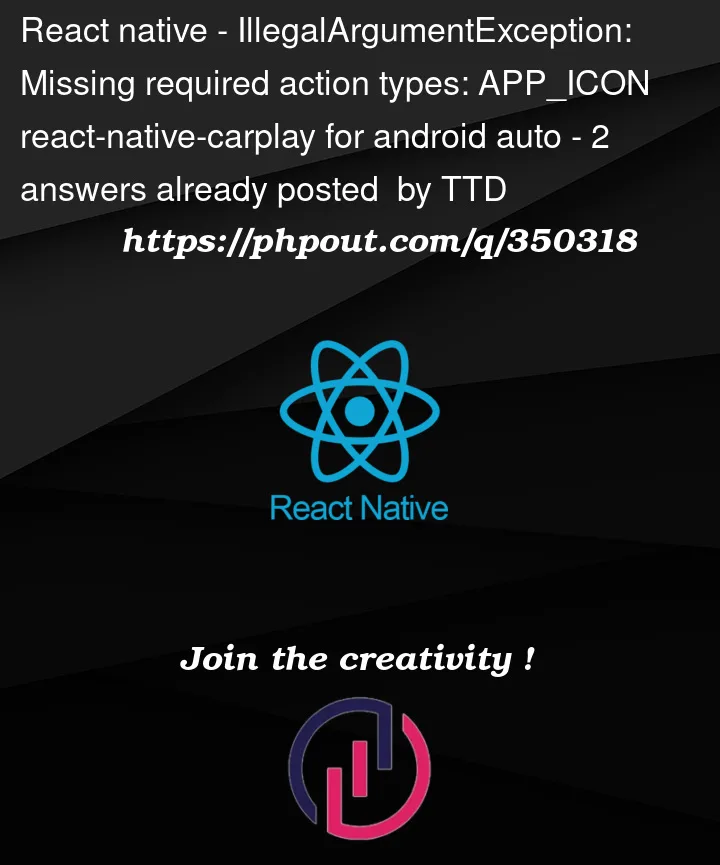I’m in the process of creating an application for Android Auto using react-native-carplay. Unfortunately, the documentation lacks details on configuring the TabBarTemplate. To work around this, I delved into the library’s code to understand its functionality. Based on my findings, I’ve established the following configuration:
import {GridTemplate, TabBarTemplate} from 'react-native-carplay';
import {img_1, img_2} from './templates/file';
const gridItemImage = require('../assets/img/go.png');
const gridTemp = new GridTemplate({
buttons: [
{
id: 'Odo',
titleVariants: ['Odo'],
image: gridItemImage,
},
],
title: 'TSC',
id: 't1',
});
const gridTemp2 = new GridTemplate({
buttons: [
{
id: 'Odo2',
titleVariants: ['Odo122'],
image: gridItemImage,
},
],
id: 't2',
title: 'TSC',
});
export const tabBarTemplate = new TabBarTemplate({
title: 'TSC',
headerAction: {type: 'back', appIcon: ''},
templates: [
{
title: 'tab1',
id: 't1',
icon: {uri: img_1},
template: gridTemp,
},
{
title: 'tab2',
id: 't2',
icon: {uri: img_2},
template: gridTemp2,
},
],
});
However, When I run the app, it throws this error:
java.lang.IllegalArgumentException: Missing required action types: APP_ICON,
at androidx.car.app.model.constraints.ActionsConstraints.validateOrThrow(ActionsConstraints.java:394)
at androidx.car.app.model.TabTemplate$Builder.setHeaderAction(TabTemplate.java:235)
at org.birkir.carplay.parser.RCTTabTemplate.parse(RCTTabTemplate.kt:32)
at org.birkir.carplay.parser.RCTTabTemplate.parse(RCTTabTemplate.kt:11)
at org.birkir.carplay.parser.TemplateParser.parse(TemplateParser.kt:30)
at org.birkir.carplay.CarPlayModule.parseTemplate(CarPlayModule.kt:92)
at org.birkir.carplay.CarPlayModule.createScreen(CarPlayModule.kt:284)
at org.birkir.carplay.CarPlayModule.getScreen(CarPlayModule.kt:294)
at org.birkir.carplay.CarPlayModule.setRootTemplate$lambda$2(CarPlayModule.kt:139)
at org.birkir.carplay.CarPlayModule.$r8$lambda$cp18Ybhsx4k_Ka2Moa-_hKNT4FY(Unknown Source:0)
at org.birkir.carplay.CarPlayModule$$ExternalSyntheticLambda5.run(Unknown Source:4)
at android.os.Handler.handleCallback(Handler.java:938)
at android.os.Handler.dispatchMessage(Handler.java:99)
at android.os.Looper.loop(Looper.java:236)
at android.app.ActivityThread.main(ActivityThread.java:8061)
at java.lang.reflect.Method.invoke(Native Method)
at com.android.internal.os.RuntimeInit$MethodAndArgsCaller.run(RuntimeInit.java:656)
at com.android.internal.os.ZygoteInit.main(ZygoteInit.java:967)
Can anyone with experience with Android Auto help me? Thank you, buddy, so much!!!




2
Answers
After dedicating several hours to a meticulous examination of Android Auto documentation and an in-depth analysis of the library's codebase to comprehend its operational mechanisms, I successfully identified and implemented a solution to resolve the issue.
A header Action of type TYPE_APP_ICON is required.
You can read more details here
The error message you’re seeing is indicating that the header action you’re trying to set for your TabBarTemplate is missing the required action type APP_ICON. In your code, you’re setting the header action as follows
The issue here is that you’re using the ‘back’ action type, which requires an appIcon. However, you’re setting the appIcon as an empty string, which is causing the error.
To fix this issue, you can either use a different action type that doesn’t require an appIcon, or provide a valid appIcon. If you want to use the ‘back’ action type, you’ll need to provide a valid appIcon. Here’s an example of how you can do this